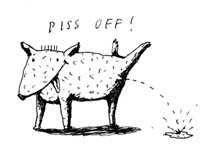swiss felix pfaffli (aka feixen) – one of the most versatile imagemakers i've ever come across
above are some of his posters for Südpol







Design a poster that celebrates “2010, International Year for the Rapprochement of Cultures".
Entries are limited to text and images only.
Designers have complete creative liberty, and may freely use in their design the title of the Year ("2010, International Year for the Rapprochement of Cultures") in any of the following six languages that they are most comfortable using: English, French, Spanish, Russian, Chinese, Arabic.
Entrants are free to play with the title in more than one language, but should not use a language they do not write fluently (for example, Chinese, Arabic, Russian).
Please verify the proper spelling of the full title of the Year as shown here.
NOTE THE FOLLOWING STIPULATIONS:
Incorporating the title of the Year in your poster design is optional, not mandatory.
Entrants must keep in mind the international nature of UNESCO and the celebration of the Year and avoid any reference to a particular country, region, culture or religion.
The final printed poster will be A1-sized (59.4 x 84.1 cm or 23.4 × 33.1 in). Although the online entry provisions do not allow for the full A1 dimensions, your entry must include at least one image showing the entire poster design scaled to A1 proportions. Note the “Entry Provisions” section outlined further down the page.
You must not include any logos on your design but instead use a placeholder. The final printed posters will include the UNESCO/UN logos + the official Logo of "2010, International Year for the Rapprochement of Cultures". To accommodate these in the poster design, entrants must save a place in their design where the official logos would be positioned in the event that your design is selected as one of the 50 to be showcased. The placeholder should be scaled to 9cm x 9cm relative to an A1 poster, and be positioned in the upper left hand corner of your poster. Click here to download the placeholder example. Since screen resolutions are different across computers, if the placeholder we have supplied does not measure 9cm x 9cm on your screen, you may recreate it to the 9x9cm dimensions.
Any person submitting a design within the framework of the competition certifies and warrants that his/her proposal does not violate the rights of a third party or any copyright.
All entrants must consult and agree to the competition Rules (see the Rules tab).
Entries should be submitted in the format of a web-resolution jpeg of 72dpi. See the “How to Enter” section in the competition Rules for more details on image and file sizes.
Additionally, entrants should have their design readily available in a 300dpi print resolution PDF in case their poster is selected as one of the 30 to be printed. If your design is chosen to be printed, and you have verified in writing your acceptance of the usage terms, you would need to add the official logos (mentioned above in the "Design Brief") which would be supplied to you by UNESCO. (See "Proposed Usage of Winning and Selected Designs," below, for more details).
Each design submission should be accompanied by a description (French or English only, 400 words maximum) describing the design and what it intends to illustrate.
Entries that direct users away from the DESIGN 21 website will be disqualified.
A Poster Wall for the 21st Century
On the occasion of the opening of the new Graphic Design Museum in Breda (NL) the posterwall for the 21st century was launched, both online and as an installation in the museum itself. In the museum 600 unique posters are automatically generated daily using content gathered from various internet sources. Online, one new poster is generated every five minutes. Constantly new and updated, the posters contain content covering a range of topics such as cultural events, news, weather, etc. In the museum it’s placed at the end of the overview exhibition ‘100 Years of Graphic Design in the Netherlands’. It attempts to provide insight into the direction graphic design might go in the future while posing the question: ‘Do we still need graphic designers?’
De ‘Affichemuur voor de 21ste eeuw’ is onderdeel van de semi-permanente tentoonstelling ‘100 years of Graphic Design in the Netherlands’ in het nieuwe Graphic Design Museum te Breda. Het is een dynamische wand die -vanuit talloze internetbronnen- affiches genereert van o.a. culturele evenementen, nieuwsberichten, maanstanden en het weer. Elke vijf minuten wordt er een nieuwe, unieke poster gemaakt die automatisch wordt toegevoegd aan de 'muur'. Het project probeert een blik te geven op de richting waarin het vak grafisch ontwerpen zich in de toekomst kan bewegen, terwijl het de vraag stelt of grafisch ontwerpers überhaupt nog wel nodig zijn? Kijk ook bij de rubriek OOG van De Volkskrant...





